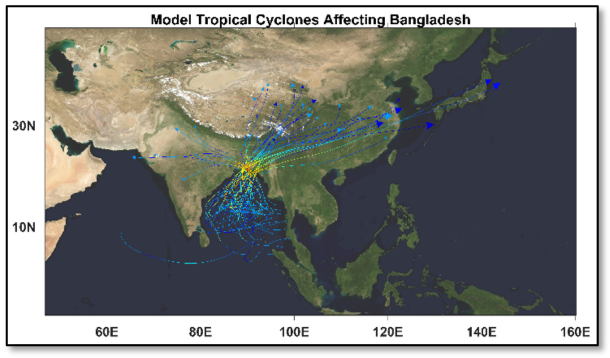Impacts of Climate Change in Bangladesh
According to the Global Climate Risk Index 2021, Bangladesh is ranked seventh among the top ten nations most impacted by climate change between 2000 and 2019. It is predicted that by 2050, 13.3 million Bangladeshis will be internally displaced due to climate change. The country is suscpetible to increased riverine and urban flooding, flash floods, tropical cyclones and storm surge, drought, extreme heatwaves, salinity intrusion, and sea level rise. It currently faces annual GDP losses of 1.3% due to climate events, projected to rise to 2% by 2050.
Bangladesh is taking action toward climate mitigation and adaptation. Landmark documents include the National Adaptation Programme of Action (2005), Bangladesh Climate Change Strategy and Action Plan (2009), Bangladesh Delta Plan 2100, Mujib Climate Prosperity Plan, and the National Adaptation Plan 2023-2050 (NAP, 2022). According to the NAP, the government of Bangladesh currently spends 6-7% of its annual budget on climate adaptation activities. Climate adaptation activities span all sectors, including agricultural production and fisheries, disaster resilience, and water security—areas where JO-CREWSnet has chosen to focus.

Data Collection and Climate Forecasting
Our team is working to collect data and produce new modeled data for deeper understanding of future regional and local climate conditions in southwest Bangladesh.
Current efforts are focused on
- Extreme heat
- Tropical cyclones
- Soil and surface water salinity
- Land use and agricultural productivity
- Future economic conditions
Check out our latest resources related to these efforts! Additional data products and regional climate models produced for Bangladesh will be referenced here as they become available.
Extreme Heat Forecasting
The Eltahir Group (MIT), a core member of the JO-CREWSnet team, recently completed relevant work modeling regional extreme heat conditions. This video explains how extreme heat causes harm to the human body and how regional climate models shed light on future health risks from extreme heat events.
The Eltahir group projected future heat stress in Bangladesh by estimating the change in wet bulb temperature. These data inform JO-CREWSnet's projects related to agricultural adaptation and climate resilient housing.
Tropical Cyclone Modeling
Additionally, the Earth Signals and Systems Group (MIT) has produced simulated tropical cyclone tracks passing through Bangladesh and data forecasting future inundation and windspeed risk. These data products will inform JO-CREWSnet's activities on climate resilient housing and shelter during severe weather events.
CREWSnet Flagship Initiatives
JO-CREWSnet welcomes BRAC, the world's largest NGO, who has over 50 years of experience working to improve the lives and livelihoods of Bangladeshis, to developing innovative climate adaptation interventions using advanced regional climate forecast data.
We are focused on three flagship field initiatives:
- Climate-resilient housing and storm shelters >>
- Agriculture and adaptation clinics >>
- Water security >>
These initiatives are focused on the Upazilas of Shyamnagar, Assasuni and Keshabpur in coastal, southwest Bangladesh, regions selected by BRAC. Information products and decision support tools developed for these regions will be adapted and scaled to other parts of Bangladesh and other countries.
Outcomes and Impact
While the flagship initiatives are underway, JO-CREWSnet's five-year vision includes the production of tools and innovative adaptation approaches that have wide-reaching impacts across Bangladesh--and beyond!
Decision support. Our team will refine, test and scale an open‑source climate and economic impact forecasting system, with effects predicted at the 10‑kilometer scale, and share these forecasts at household, community and regional levels to empower 10 million people and six communities in southwestern Bangladesh. Leveraging our new data and models, JO-CREWSnet will assess if, when and how ecosystems in southwestern Bangladesh will exceed their capacity to sustain human life, or where adaptation in place is possible. Where adaptation is possible, the team will work with local communities to implement climate resilience technologies; elsewhere, Jameel Observatory-CREWSnet will work with communities to proactively manage disruptive change.
Information sharing. To reach the widest audience in Bangladesh, JO-CREWSnet will build a suite of information sharing tools designed for two way, multimedia communications to support low and high literate populations as well as urban and rural demographics.
Customized services and technologies. Jameel Observatory-CREWSnet will help Bangladeshis implement climate resilience decisions through customized, community‑based services and technologies that leverage the team’s existing programs in livelihoods and job opportunities; climate-resilient housing; climate‑smart agriculture and irrigation; power, water, sanitation and hygiene; disaster preparedness; and new initiatives including adaptation clinics now being piloted by BRAC in Bangladesh. JO-CREWSnet’s highly localized forecasts will help households make relocation decisions and strengthen efforts to prepare communities across Bangladesh to receive those who choose to move.
A model for other regions. Our team will monitor and evaluate the impact of key components of this integrated approach for the people of southwestern Bangladesh, incorporating community involvement and feedback at every stage of the project. Initially demonstrated in Bangladesh, the project will serve as a model for similarly threatened regions around the world.
Flagship Initiatives in Bangladesh >>





